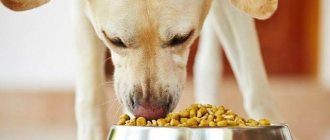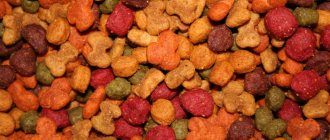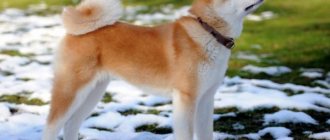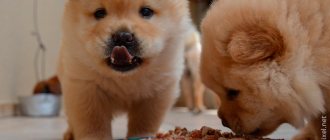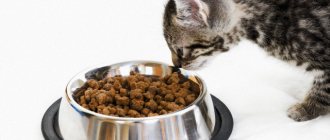Pugs are an ancient breed of decorative dogs that have gained immense popularity around the world. The basis of high-quality pet care is the preparation of a diet that will avoid most health problems and extend the pet’s life to the maximum possible. Despite its activity, the breed is prone to obesity. In this article, we will figure out what type of food is best to choose for a pug, what feeding regimen is needed for a puppy and an adult dog, and we will find out what to do if a negative reaction to food occurs.
Feeding dry food
Industrial feeds are offered by manufacturers in a huge range. The main problem for the owner will be choosing the one that will satisfy the needs of the pet.
Using ready-made food makes life much easier, since the manufacturer indicates recommended feeding portions.
Pugs' stomachs handle solid foods best, so feeding them dry kibble is a great option. Please note that this breed should not use a mixed type of food: ready-made food in the morning, natural food in the evening. Such experiments will lead to gastrointestinal upset of the animal.
In addition to dry food, wet canned ready-made food can be introduced into the diet. This product can be used as independent feeding or added to natural food. For example, mix with cereals.
Soaking dry granules is allowed, but you should not do this with boiling water, because most of the vitamins and microelements will be destroyed. You can do this with milk or kefir, but you should not leave such a portion of food for re-feeding. You'll have to throw away anything your pug doesn't finish eating.
Photo: pixabay.com
Foods that are prohibited for pugs
Considering the digestive characteristics of this breed, they cannot eat the following foods:
- pasta;
- semolina;
- potato;
- sugar and baked goods;
- fresh bread;
- sausages, frankfurters, smoked meats, semi-finished products;
- pickles and marinades;
- various seasonings;
- mushrooms;
- corn and peas;
- grapes, oranges, raisins;
- mayonnaise, sour cream, cream;
- raw egg white;
- fatty, fried and overly salty foods.
What will be the consequences of violating prohibitions?
Caring for pugs is quite complex and specific in nature. If you do not follow all the subtleties of nutrition, this can lead to:
- obesity (excessive overfeeding);
- disturbances in the functioning of the nervous system and even loss of consciousness (in case of potassium deficiency);
- circulatory disorders (in case of an incorrect combination of potassium and phosphorus);
- problems with teeth, hair and skin (in case of lack of vitamins).
If you notice that your pug is not active, constantly lies down and wants to sleep, and its fur and skin leave much to be desired, then you should think about the correctness of your pet’s diet. Perhaps he lacks vitamins or is oversaturated
food.
Feed comparison
There are several types of feed that are considered “pedigree” and are recommended for use. The specific type is selected taking into account the dog’s preferences, veterinarian advice and the animal’s diseases.
Royal Canin
In the line of this brand there is a specialized food designated “pug”. Translated from English, the word means pug, flat nose. The granules are made in the shape of a trefoil, which makes them easy to grasp for those with a flat muzzle. The composition of Royal Canin is balanced and rich.
Photo: amazon.com
Canidae
Holistic from the USA, which includes everything you need for a pug pet. There is meat, meat flour, vegetables, probiotics, medicinal herbs.
Photo: amazon.com
Acana
Belongs to the holistic class, which is most preferable for pug nutrition. It contains about 60% natural meat, a complex of minerals, fruits, vegetables, and medicinal herbs, which have a positive effect on the functioning of the gastrointestinal tract. There are no flavorings or by-products that can cause allergies.
Photo: amazon.com
FirstMate
Belongs to the super premium class, produced in Canada and Australia. It has a very diverse composition, not inferior in quality to natural: three types of meat, vegetables, minerals, vitamins. Interestingly, the meat included in the composition belongs to the Human Grade category, that is, it can be consumed by humans.
Photo: amazon.com
If possible, the owner should choose holistic foods that eliminate as much as possible the body’s negative reactions to nutrition. A noticeable disadvantage of this choice is the high cost, which, however, cannot be compared with the cost of treating the consequences of using low-quality feed.
We also performed a detailed analysis of the following feeds: Proplan, Monje, Dog Chow, Brit.
When to change food
Any owner always closely monitors the condition of his pet. There are several reasons why you should change food:
- The pug simply refuses to eat it;
- The first signs of weight gain are noticeable;
- The dog is not gaining weight well and is not active. Choose a higher-calorie type of food without increasing portions;
- Signs of an allergic reaction appeared: scabies, dull fur, sores.
List of the best food for pugs
Natural foods are better suited to your dog's needs than commercially prepared foods. But I recommend feeding your pug dry kibble, which is balanced in all nutrients and does not require additional supplements of microelements and vitamins. The table shows the foods that owners consider the best for pug puppies.
| Name | Package weight, kg | price, rub. |
| 1. Hill's Science Plan for Small Breed Puppies | 1,5 | 936 |
| 2. Acana puppy for small breed puppies | 2 | 1561 |
| 3. Royal Canin Pug Puppy for pugs | 1,5 | 933 |
| 4. Brit care mini puppy | 2 | 1247 |
| 5. Eukanuba for small breed puppies | 2 | 976 |
Hill's Science Plan for Small Breed Puppies
American-made super premium granules do not contain artificial pigments, flavors, or preservatives.
Animal feed is provided by poultry meat. Wheat and corn allergens were destroyed during pelleting. Fish oil and flax seeds ensure healthy skin and beautiful coat. Sugar beets, spinach, citrus fruit and tomato squeezes contain vitamins, antioxidants and substances that nourish beneficial microbes of the large intestine.
Acana puppy for small breed puppies
Canadian holistic consists of components that are used for human nutrition. Manufacturers used meat from birds raised in the wild, fish caught in the ocean, vegetables, fruits, and culinary seasonings.
The granules do not contain cereal grains, 70% of the mass is represented by meat and fish. Acana, according to reviews from dog breeders, is the best food for pug puppies, but also the most expensive.
Royal Canin Pug Puppy for Pugs
Manufacturers have developed a recipe specifically for pugs. The feed is produced by mars divisions located in France, Poland and Russia.
The super premium ready-made food includes the following ingredients:
Royal Canin is inferior to holistic products in the range and quality of nutritional components, but contains natural prebiotics - fructooligosaccharides, mannanoligosaccharides, which prevent digestive disorders. Yucca extract reduces stool odor.
Brit care mini puppy
Czech holistic is similar in composition to Canadian.
The granules do not contain components that can cause an allergic reaction. The meat part of the diet is represented by young lamb. Manufacturers have included substances that strengthen the immune system, improve digestion, and reduce the smell of excrement.
Eukanuba for small breed puppies
Premium granules are produced in Poland or Russia. In terms of composition, Eukanuba is inferior to super premium and holistic foods.
Despite the poor composition, dry food does not cause any complaints from most owners and has the lowest cost.
Choose ready-made food that the baby likes, does not cause diseases of the fur, skin, teeth, and is affordable.
Natural diet
When choosing natural food for a pug, the owner faces a number of difficulties, since he will have to independently create a balanced menu, calculate the serving size and provide additional nutrition to the animal with vitamin complexes.
Often suffering from obesity and allergies, Pugs will eat anything in sight. It is difficult for the owners to refuse a baby who looks pitifully at them with his beady eyes. Here is an example of such behavior!
Feeding your pug regular food is strictly prohibited.
The diet must include:
- Meat and meat products – at least half of the daily portion. It could be beef, rabbit or turkey;
- Cereals make up almost a quarter of the diet. Usually they use rice, buckwheat or oatmeal, focusing on the pet’s taste;
- Dairy products. About 20% should be fermented milk products. Interestingly, it is recommended that pugs be given low-fat milk in their diet. It helps cope with heartburn, which often torments dogs;
- Fish – boiled or raw, but strictly without bones;
- Fruits and vegetables. Vegetables are given stewed, fruits are given raw.
Meat and dairy products should not be given at the same feeding. This will lead to gastrointestinal upset.
Dogs do not need a varied diet, the main principle is balance. During the week, the owner should change cereals, leaving about 60% meat in the diet and adding various vegetables.
What is possible and what is not?
Permitted products include:
- Lean meats (beef, chicken, turkey, duck, rabbit).
- Milk and fermented milk products (kefir, yogurt, low-fat cottage cheese).
- Fresh vegetables, fruits, berries, a variety of greens.
- Fish (both canned and fresh).
- Various cereals (except corn and legumes).
- Fruits, vegetables, herbs.
- Industrial dry food.
It is advisable to serve fresh vegetables and herbs in chopped form.
It is recommended to exclude the following range of foods from your pug’s diet:
- Flour products made from white flour (in any form).
- Various semi-finished products.
- Raw eggs.
- Sour cream, cream and mayonnaise.
- Spices, seasonings, ketchup, sauces and marinades.
- Smoked products.
- Ice cream, candy, chocolate, cakes and any foods high in sugar (including those with sweetener).
- Fatty meat (especially pork).
- Potatoes (both fried and boiled).
- Corn and legumes (including soybeans).
- Mushrooms (in any form).
- Sausages, frankfurters and small sausages.
- Sharp and tubular bones.
- Citrus fruits (oranges, lemons).
- Raisins and grapes.
- Pasta.
- Porridge made from wheat and semolina.
- Any fried foods.
What to feed a pug puppy
It's no secret that a baby's diet and menu are different from those of an adult dog. Let's figure out what to feed a little pug.
Keep the type of food that the baby received in the nursery. Transfer to another type should be done only after three weeks.
From 1 month
The puppy begins to develop very actively, so it needs more satisfying and nutritious food. During this period, you can already give him low-fat kefir, cottage cheese, and boiled vegetables. If ready-made food is used, the puppy is given soft, wet kibbles intended for babies his age.
Puppies are fed 6 times a day. The serving size is calculated based on the weight of the pet. It is believed that the daily requirement is 5-7% of the dog’s weight. If the puppy weighs 2 kg, the consumption rate will be 140 g. This figure is divided by the number of feedings per day, resulting in a portion size per feeding.
This is how the baby receives complementary foods for the first time, look!
From 1 to 6 months
As the pug gets older, the number of feedings per day decreases to three, and with them the serving size. By six months, the serving size is calculated using the formula: 4% of the animal’s weight.
From 6 months to a year
The dog's diet includes all the products that an adult dog needs. By this time, the dog is transferred to two meals a day.
Compliance with the diet is especially important for the breed. If the dog refuses food, it should be put in a cool place. There is no need to increase the portion at the next feeding.
Basic principles
The pug's digestive system is very delicate and sensitive. Although small dogs are capable of eating anything, you should not indulge their whims. You cannot feed your pet all foods in a row. This approach will lead to the development of serious illnesses, obesity and even the death of your four-legged friend.
One of the principles of proper nutrition is regimen. Feeding at strictly prescribed times and portion sizes adjusted according to age will help avoid health problems.
A bowl, even with half-eaten food, must be removed immediately after eating. If the dog begs for more, you will have to control yourself and not give in to your pet’s whims. A double portion will only do harm.
To avoid harming the pug's delicate digestive system, it is fed warm, solid food. Food that is too liquid can cause stomach upset. Dog owners need to ensure that there is always a bowl of clean (not tap) water and milk where the dog is fed.
What to feed an adult pug
Ready-made food should be premium class or higher; preference is given to holistic food.
We must not forget that the dog must be provided with access to clean water, which must be changed twice a day.
Natural food should be warm. The meat is cut into small pieces, convenient for consumption. Vegetables and fruits are given both raw and stewed. Many pugs refuse to eat them, so training for such foods begins very early. For example, Tasha doesn’t really agree, but she chews the zucchini and carrots very carefully!
It is advisable to choose the type of food once and for all, since transitions from one type to another can have a detrimental effect on the animal’s digestion.
An adult dog is fed twice a day. For example, at 7 am and at 22 pm. It is acceptable to give an afternoon snack, but you should not get carried away with all sorts of goodies.
List of food items
Your pet's diet must include:
- Tangerines, apples, bananas (half or 1 small fruit per day, at the dog’s request).
- Dates and dried apricots (1 - 2 pieces per day).
- Porridge (preferably buckwheat, oatmeal or rice).
- Boiled eggs (2 - 3 pieces per week).
- Low-fat milk.
- Greens and vegetables (in small quantities every day, for example, as a side dish to the main dish).
- Brown bread (1 slice per day is allowed, for example, with butter or cheese).
- Cottage cheese (except for sweet curds with fillings).
Sometimes you are allowed to pamper your pet with a small piece of salted fish.
How to feed an old dog
With age, the activity of pugs fades away, which is a signal to revise the menu. In addition, diseases that occur with age are also taken into account.
An older dog's food should be less high in calories and contain less fat and protein. Older representatives of the breed are prone to constipation, so it is necessary to provide the body with fiber. For example, wheat bran.
If the need to review the diet is dictated by age-related diseases, you should consult a veterinarian.
Vitamins and mineral supplements
Ready-made food contains all the necessary vitamins and mineral supplements, so with this type of feeding there is no need to purchase additional medications.
A natural diet is not able to fully provide the body of a growing baby with vital elements.
Remember! It is recommended to purchase any vitamin and mineral supplements only in specialized stores; the name and dosage depend on the age and physiological state of the puppy and are determined by a veterinarian.
With proper feeding, clumsy cute lumps grow into healthy, cheerful pugs with proper bones and muscles, shiny coat and excellent health.
Feeding pregnant and lactating bitches
The diet of a pregnant bitch is not very different from usual. It should be additionally enriched with vitamins and calcium. Use special feed or natural food supplements.
During this period, the bitch’s taste preferences change; she may beg for inappropriate foods. This indicates a lack of vitamins.
After childbirth (the first 10 days) there is no need to give meat products to exclude eclampsia. During this period, the bitch is supported with vitamin supplements and dairy products.
What vitamins are needed?
Vitamins that a pug needs for good health:
- vitamin A . Necessary for the good development of pug puppies, including the period of mating, pregnancy, and lactation. It is found in tomatoes, greens, carrots, liver, milk, fish oil and egg yolk;
- vitamin B. To keep your pug's skin and muscles healthy and strong, this vitamin is needed. It is found in liver, brewer's yeast, dairy products and greens;
- vitamin C . Prevents diseases of the gums and joints, improves the body's immune system. It is found in fruits and vegetables;
- vitamin D. Necessary for a growing dog - it prevents rickets, strengthens bones;
- vitamin E. It is a reproduction vitamin and is needed by pugs during periods of mating and pregnancy. Contained in beets, carrots, greens and cereals.
How to avoid obesity
Pugs are ready to eat everything that seems tasty to them. This eating behavior often leads to obesity, which leads to heart problems and early aging of the pet. To avoid obesity follow the rules:
- Do not offer additional snacks to your pet;
- Limit treats;
- Carry out periodic weighing;
- If the weight creeps up, contact your veterinarian for a diet prescription.
Photo: wikimedia.org
If a dog refuses to eat: reasons
A pug may not eat for a variety of reasons. For example, because he is spoiled. Then it’s enough to remove the bowl for a day; if after that he doesn’t eat, then you should worry.
Refusal to eat occurs against the background of infectious diseases, gastrointestinal disorders, and heat stroke. In any case, your pet should be shown to a veterinarian.
Important! If a dog is bitten by a tick, then lethargy and refusal to eat are signs of piroplasmosis, and you should urgently consult a doctor.
The appearance of an animal in the house is a joyful event. To prevent the issue of organizing your pet’s nutrition from becoming painful, it is better to familiarize yourself with all the intricacies before purchasing a pug.
Treatment of diseases with food
In the presence of various types of diseases, it becomes necessary to transfer the pet to specialized food, either completely or partially. Please note that in this case you will have to give up natural food and switch to ready-made medicinal food.
Naturally, not just any disease can be cured with dry food, but for example: obesity, allergies, molting, indigestion. Almost all premium food lines have products that can be used for these problems. It is better to choose specialized food of the brand that the dog is currently eating.
Nutrition for older dogs
The condition for a long life is good nutrition. After seven years, the diet is made less calorie, reducing the percentage of proteins and fats. Sample list of products:
- meat or fish - 50%;
- porridge - 30%;
- other - 20%.
There are tons of step-by-step tutorials out there that show you how to prepare formula for pugs.
There are food lines for older pets
Newborn puppies
Quite rarely, but there are situations when for some reason the dog cannot or does not want to feed the puppies. Only a person can help them in this situation. What to feed a newborn pug puppy. The ideal option in this case would be powdered milk from a nursing bitch, which can be purchased today at a pet store. Each feeding a new portion is prepared.
You're probably wondering how much to feed your pug puppy. Newborn babies should be fed at least six times a day. These babies will need special nipples and bottles. If the pet store does not have powdered milk, then infant formula is suitable for feeding tiny pugs. Never use goat's or cow's milk.
What to do if you don’t eat for the second day?
It often happens that a pug skillfully manipulates its owners, not touching the food and waiting for a more tasty morsel.
If the dog does not eat for 2 days, but drinks water, is active, goes to the toilet well, does not have a fever or pale mucous membranes, there is no need to worry. Fasting days will only benefit your pet.
But if any of the symptoms described above appear in your anamnesis, you must urgently contact a veterinary clinic to establish an accurate diagnosis.
Disadvantages of homemade food
A significant drawback is the need to balance the components so that the body does not create an excess of one substance with a deficiency of another.
So, for example, when feeding exclusively meat tenderloin, an increase in phosphorus in the blood is inevitable, while calcium levels decrease. And hence problems with bones, joints, and fur. It is best if the initial diet is compiled by a nutritionist, based on laboratory blood tests of a particular individual.
Another disadvantage of this feeding is the time spent preparing food. Meat, in most cases, does not require heat treatment. However, washing, cutting, and arranging the bowl takes time, and this time is much longer than what is required when pouring ready-made food.
Well, perhaps the last disadvantage is the price. When feeding high-quality natural food, its cost is comparable to the level of good super premium food.
